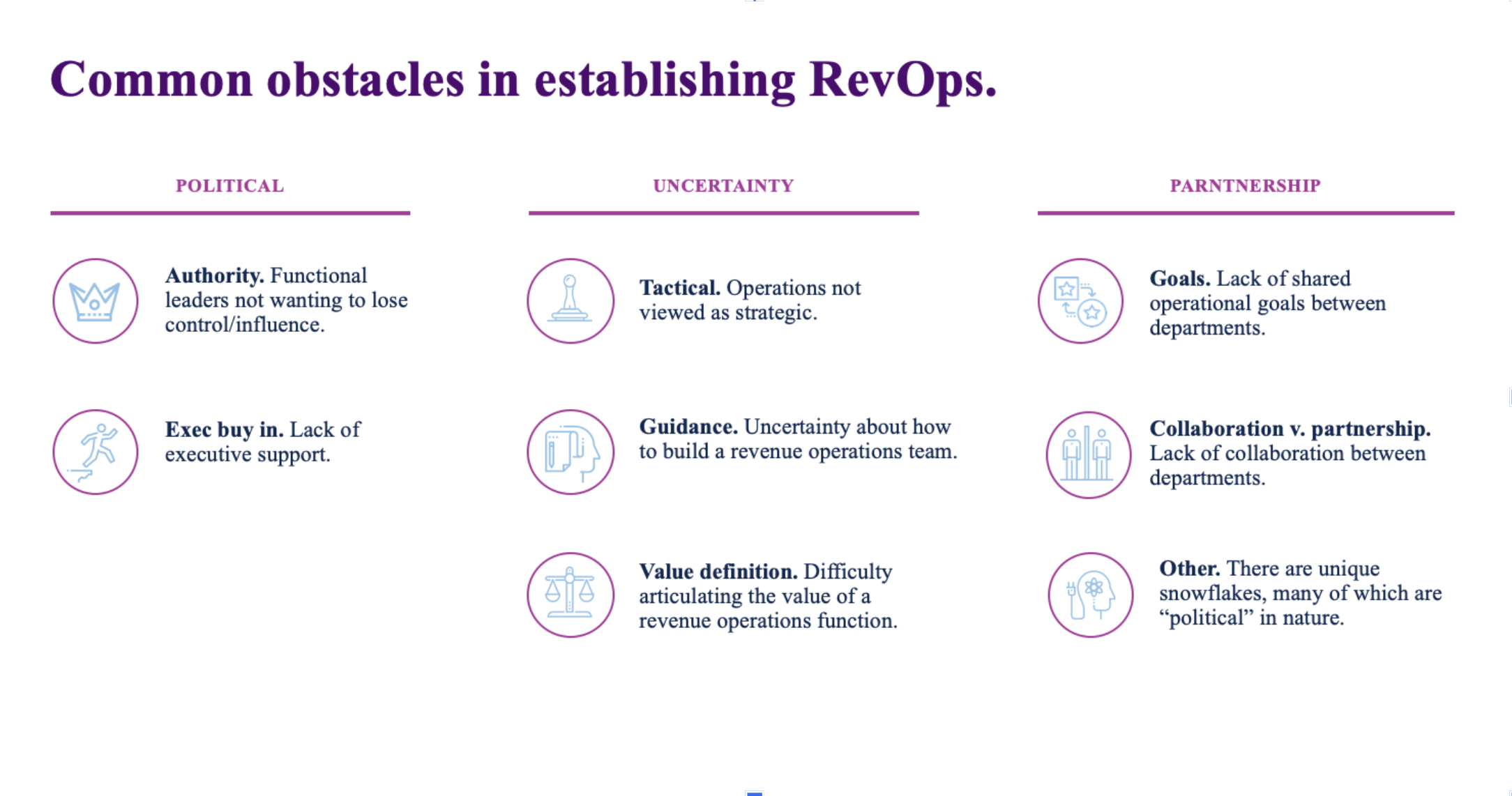Blog


Okay, you’ve seen the benefits of RevOps and understand that it’s in your organization’s best interest because it improves the dynamics between your departments and keeps everyone focused on the same goals and KPIs. That all sounds great, but what’s the catch and what are the challenges?
Broadly speaking, common challenges with RevOps fall into three categories; politics, uncertainty, and partnership.
- Politics. There is often a hesitancy from executives that may not wish to relinquish control of their operational resources
- Uncertainty. People are often afraid of the unknown, and not having a clear path on how to move forward can be scary.
- Partnership. The partnership gets into departmental alignment. There’s a frequent concern that when operations teams come together, there will be a lack of shared goals or that there’s a lack of partnership between operations teams as-is.
Perceived obstacles in establishing centralized RevOps
Goals and authority are the two largest perceived obstacles in establishing a centralized RevOps function, as referenced by individuals that don’t have one in place but are considering it.
- Goals. Setting up a centralized RevOps function means putting forth joint goals instead of siloed tactics from each department. In turn, a lack of shared operational goals and a lack of current collaboration levels are the most cited concerns. In addition, if there is currently not a strong relationship with other operational teams, often there’s a sensitivity on aligning on shared goals, and in doing so, actually removing goals and objectives that an operations team currently focuses on.
- Authority. Functional leaders not wanting to lose authority is often brought up as an obstacle when discussing RevOps. This response is primarily driven by functional leaders that equate the number of people reporting to them to their status and prestige. As such, RevOps risks reducing their stature. There is also a concern that RevOps may limit a person’s career trajectory because if there’s only one head of sales, marketing, and customer success operations, there’s only one senior position for “operations.”
Actual obstacles in establishing centralized RevOps.
The challenges that you perceive, however, are not necessarily the actual challenges–or to the severity, you might suspect. It’s one thing to watch someone run in a marathon, but it’s quite another to train and do it yourself. So, what are the actual biggest obstacles in setting up RevOps? After examination, these are the two most significant issues flagged by companies that have actually established a centralized revenue operations team function.
- Value definition. Difficulty articulating the value of RevOps is more of an issue than anything else. Despite the fanfare, the newness of this function is like owning a cell phone in 2002 vs 2020. Selling RevOps to senior executives is difficult because more often than not, they’re less knowledgeable on the organization’s operational backbone than you are. To help them understand, try using presentations and reports that help support your business case. Also, look to peer leaders in other organizations that have already rolled out revenue operations. Ask them about the business benefits and what their transition looked like.
- Collaboration. Fear of the unknown is a common obstacle. How will team members like working with the other operations staff members? While the fear of not collaborating with new people is present, it’s not a deal-breaker. Simply start by introducing the teams to each other more and more beforehand. Have people sit in on meetings with another team to observe and learn from them. Sit the teams closer to each other so they can naturally run into each other more often to organically start a dialogue. Furthermore, a change in the culture is, fortunately, less of an issue. And as for getting executives on board, it goes back to the issue I flagged above – articulating the value impact of a centralized RevOps function. That will come down to your ability to make a business case and a defensible transition plan.
Also, the perceived issue of functional leaders not wanting to lose control is still a challenge listed by the companies that have established a centralized RevOps function, but the frequency that it’s referenced as a top obstacle is actually quite low. So, if this is your primary concern, it’s an issue, but it’s actually less of an issue than you think. A way to address this concern is to have senior executives talk to their counterparts at other companies that have enacted a centralized RevOps function. It often makes a huge difference to hear from two or three people that have already made that move forward.
Iron Horse Insight
Just because something may be challenging doesn’t mean you shouldn’t do it. Yes, RevOps is new, and yes, there are challenges, but there are also significant benefits. The key is understanding where the challenges and pitfalls are in advance—so as to learn from their struggles and hardships. Doing so will help you avoid making the same mistakes so that you can enjoy the benefits of RevOps.
Subscribe to our blog.
Get unstuck with the most interesting business ideas and our insights delivered to your inbox.